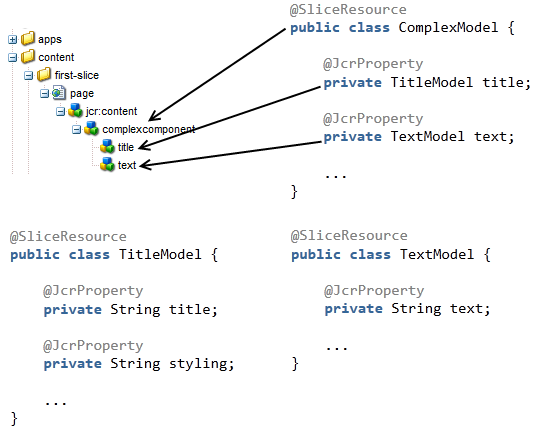...
If you want a resource to be mapped to an Java object, you have to meet to three requirements:
- class must be annotated with
@SliceResource, - object must be created using injector. All classes annotated with
@SliceResourceare bound toSliceResourceProviderwhich is responsible for reading a current resource and invoking mapping to an object. Usually, you will be usingModelProviderto specify from which resource to map, - class cannot be nested.
You don't need to invoke anything by yourself, if an object is injected and annotated with @SliceResource it will be automatically mapped from current resource.
...
The diagram below depicts processing of an example class. Field text is processed by the DefaultFieldProcessor, similarily the number field. hideInNav field is processed by BooleanFieldProcessor and other by custom processor called FancyFieldProcessor.
Gliffy
There are a number of predefined processors which can be used out of the box. But you can also implement yours and add them to your Mapper. The predefined processors include:
...
This processor is used for recursive mapping of resources. If a field is of class annotated with @SliceResource it will be mapped from a child resource named after the field.
It is especially useful for development of complex components, composed of another components - you can then easily reuse models of your simple components. Picture below presents an example:
SliceReferenceProcessor
It processes fields which are annotated with com.cognifide.slice.mapper.annotation.SliceReference. It allows for mapping of models from a different resource (path) than a current resource
The @SliceReference annotation takes a path as a value. The value can be either an absolute path (like /content/test/home/jcr:content/par) or child path (like childResource/grandChildResource) - then it will be resolved relatively to current resource. Bear in mind that parent resources (like ../../test) are not supported.
The value of a path can contain placeholders in form of: ${placeholderName}. This can be useful when the path is dynamic and changes depending on request, e.g. contains language. Instead of hardcoding the language in the path (like: /content/site/en/home), you can put placeholder and have this path to be dynamically evaluated, e.g. /content/site/${language}/home.
The placeholders are resolved using com.cognifide.slice.mapper.api.SliceReferencePathResolver. It's an interface shipped with default implementation. Since it is intended to store a configuration of your placeholders, you must specify these placeholders. It can be done by some of your module providing the SliceReferencePathResolver object which have all placeholders added using its addReference methods. A simple snippet of code which provides the object can look like this:
| Code Block | ||
|---|---|---|
| ||
@Provides
@ContextScope
public SliceReferencePathResolver getSliceReferencePathResolver(Injector injector) {
SliceReferencePathResolver resolver = SliceReferencePathResolverFactory.createResolver(injector);
resolver.addPlaceholder("language", Language.class);
return resolver;
} |
The addPlaceholder method supports two kind of placeholders:
annotations (as in example - the Language.class is an annotation) - the specified annotation must be a BindingAnnotation and must be used for providing a String value by some module. Each placeholder stored using this method will be resolved by replacing it by a value returned by a provider of a String annotated with the specified annotation.
In order to resolve thelanguageplaceholder in above paths, some module must provideStringannotated byLanguage:Code Block @Provides @Language public String getLanguage() { String language; //some logic to set the language variable return language; }- String - specifying a String which will replace the placeholder directly.
Post processors
Post processors are dedicated mechanism for modifying values of mapped fields. It is useful when there is a need for modification of a value already mapped from a resource, e.g. to do some low-level conversion or encoding. Currently, there's only one post processor shipped with Slice but you can implement yours in order to do some arbitrary modifications. Post processors do NOT modify resources - they only modify values mapped from a resource to a field.
EscapeValuePostProcessor
When mapping a text property to a String field all HTML entities are escaped by default. The com.cognifide.slice.mapper.impl.postprocessor.EscapeValuePostProcessor modifies a text value to unescape HTML so that it can be properly displayed on a page. It should be used when a property represents a part of HTML markup, e.g. text saved by richtext component.
To use this post processor, a field must be annotated by com.cognifide.slice.mapper.annotation.Unescaped annotation, e.g.
| Code Block |
|---|
@SliceResource
public class ExampleModel {
@JcrProperty
@Unescaped
private String text;
} |
InitializableModel
It's a common task to do some stuff after the model has been mapped and its fields hold values from underlying resource. You cannot do this in the constructor of your model because mapping is done after the object has been created, so all the fields which should be mapped are null while executing constructor. Therefore, Slice introduces an interface called InitializableModel which allows you to perform an arbitrary logic after the process of mapping has finished.
...

